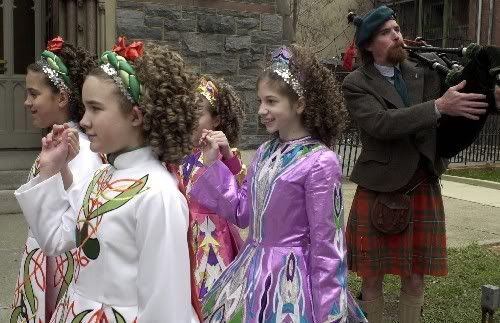国外节日专辑汇编(三月祭)
 The person who was to become St. Patrick, the patron saint of Ireland, was born in Wales about AD 385. His given name was Maewyn, and he almost didn't get the job of bishop of Ireland because he lacked the required scholarship.
The person who was to become St. Patrick, the patron saint of Ireland, was born in Wales about AD 385. His given name was Maewyn, and he almost didn't get the job of bishop of Ireland because he lacked the required scholarship.Far from being a saint, until he was 16, he considered himself a pagan. At that age, he was sold into slavery by a group of Irish marauders that raided his village. During his captivity, he became closer to God. He escaped from slavery after six years and went to Gaul where he studied in the monastery under St. Germain, bishop of Auxerre for a period of twelve years. During his training he became aware that his calling was to convert the pagans to Christianity. His wishes were to return to Ireland, to convert the native pagans to Christianity. But his superiors instead appointed St. Palladius. But two years later, Palladius transferred to Scotland. Patrick, having adopted that Christian name earlier, was then appointed as second bishop to Ireland. Patrick was quite successful at winning converts. And this fact upset the Celtic Druids. Patrick was arrested several times, but escaped each time. He traveled throughout Ireland, establishing monasteries across the country. He also set up schools and churches which would aid him in his conversion of the Irish country to Christianity. His mission in Ireland lasted for thirty years. After that time, Patrick retired to County Down. He died on March 17 in AD 461. That day has been commemorated as St. Patrick's Day ever since. Much Irish folklore surrounds St. Patrick's Day. Not much of it is actually substantiated. Some of this lore includes the belief that Patrick raised people from the dead. He also is said to have given a sermon from a hilltop that drove all the snakes from Ireland. Of course, no snakes were ever native to Ireland, and some people think this is a metaphor for the conversion of the pagans. Though originally a Catholic holy day, St. Patrick's Day has evolved into more of a secular holiday. One traditional icon of the day is the shamrock. And this stems from a more bona fide Irish tale that tells how Patrick used the three-leafed shamrock to explain the Trinity. He used it in his sermons to represent how the Father, the Son, and the Holy Spirit could all exist as separate elements of the same entity. His followers adopted the custom of wearing a shamrock on his feast day. The St. Patrick's Day custom came to America in 1737. That was the first year St. Patrick's Day was publicly celebrated in this country, in Boston. It was in Boston where the Day was first celebrated in a public way. Gradually other states took it up. And it was New York that took out the largest ever St Patrick' s Day parade. Held since 1762, the New York City parade on St Patrick's Day draws more than one million spectators each year. Meanwhile the city of Chicago has developed a unique tradition of coloring the river water green. It started in 1962 when 100 pounds of green vegetable dye were added to its river, enough to keep it green for a week. The tradition has continued till date. Now, 40 pounds of a green food coloring keep the river green for only a few hours. These apart Irish community in various cities celebrate the Day with social and community works. Making charities, attending mass, promoting their own culture, and feasting with their foods. 圣帕特里克节为3月17日,以纪念爱尔兰守护神圣帕特里克。公元432年,圣帕特里克受教皇派遣前往爱尔兰劝说爱尔兰人皈依基督教。他从威克洛上岸后,当地愤怒的异教徒企图用石头将他砸死。但圣帕特里克临 危不惧,当即摘下一棵三叶苜蓿,形象地阐明了圣父、圣子、圣灵三位一体的教义。他雄辩的演说使爱尔兰人深受感动,接受了圣帕特里克主施的隆重洗礼。公元 493年3月17日,圣帕特里克逝世,爱尔兰人为了纪念他,将这一天定为圣帕特里克节。 Music will also be present in the floral offering to the Virgin Mary on the 17th and 18th, one of the most dearly beloved acts of the fallas, when the falleros come from their casals to the square known as the Plaza de la Virgen bringing their bouquets with which they make an ephemeral cloak for the patron saint of Valencia. But everything reaches an end, and on 19th March, amidst the tears and sobs of the falleras, the fire consumes the fallas. But on this day everything also begins because with the last ashes the Valencians start to dream of the fallas of the following year, it is just like the life cycle itself. 西班牙瓦伦西亚火祭节,每年3月12日至3月19日举行,以纪念这座城市的守护神圣约瑟夫。火祭节已成为西班牙极有特色的节庆,每年都吸引成千上万游客前往当地,放火迎接春天。所谓的fallas是指上过彩的木头或纸板雕塑而成的作品。每年的这个时候,西班牙的巴伦西亚都会被人们的热情点燃。在为期一周的火祭节里,当地人用各种庆祝方式来挥洒激情,迎接春天的到来。 “火祭节”的传统起源于中世纪。当时,木匠们为了纪念他们的保护神“圣约瑟夫”,形成了燃烧木制雕像的习俗,后来逐渐演变成现在的“火祭节”。最早的木头雕像都是木匠们用下脚料做成的,随着时代的发展,雕像的制作工艺越来越精致,造型也更多样、更夸张。由于今年环境问题再度引起人们的关注,这个雕塑作品就以全球变暖为主题,希望人们提高环境保护的意识。“火祭节”期间,市政厅前每天都会举行焰火表演,而节日的高潮则是在3月19号的晚上燃烧雕像的活动。在燃烧雕像之前,当地人还要对所有的雕像进行评选,其中最受欢迎的雕像将被保留下来,存放到当地的博物馆中。
The fallas play the leading role this week because the Region of Valencia is in festive spirit and the light, the colour and the fire, above all the fire, will flood the streets and squares of the Valencian towns and cities. For five days Valencia and many other towns of the three Valencian provinces will be transformed thanks to the fallas, the music, the fireworks and the mascletás. Quite a transformation, the prologue to spring, which begins on the 15th with the plantà (the setting up of the falla monuments).
资料来源:
http://www.discoverireland.com
http://www.comunitatvalenciana.com
http://www.cctv.com
http://www.chinadaily.com.cn
 Loading...
Loading...









0 comments:
发表评论